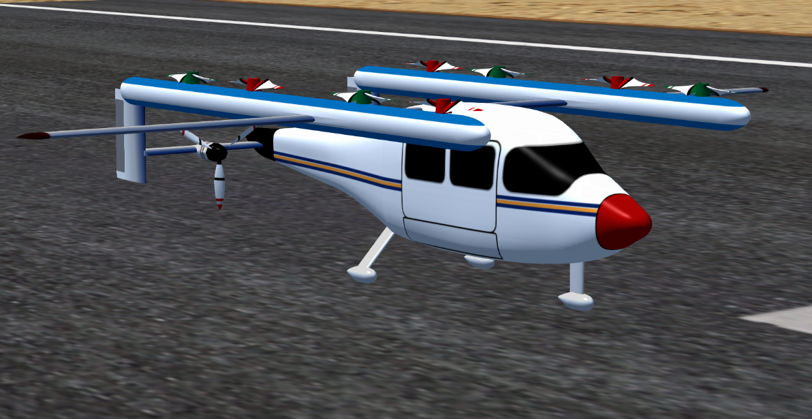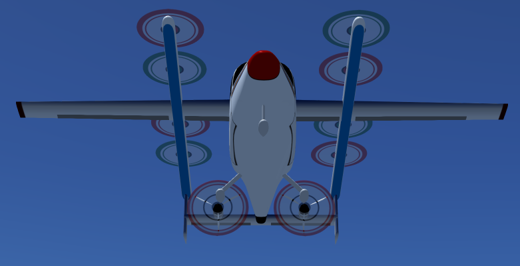Click on link for more information.
- Lift-plus-cruise (LPC) configurations
- Tilt-wing (TW) configurations
- Vectored Thrust (VT) configurations
- VT-03-s Shadow (subscale)
- VT-02 Sevak
- VT-01-s Paramveer (subscale)
- Wingless Multi-rotor (WMR) configurations
- Hexa-Chakra Personal Air Vehicle (hexa-rotor)
LPC-03 Phoenix All-/Hybrid-/Turbo-Electric UAM
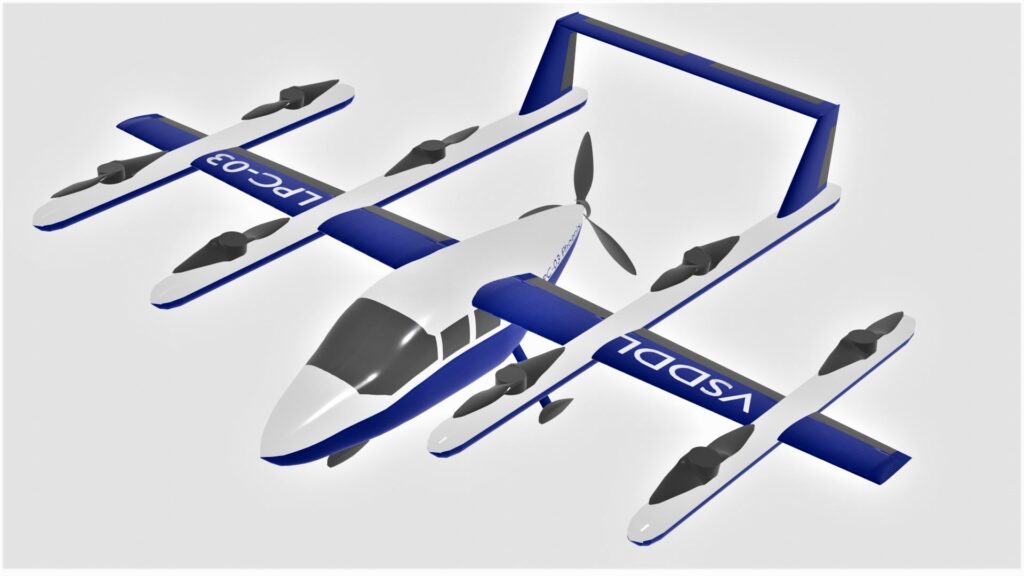
LPC-03 Phoenix is a lift-plus-cruise design using a single pusher cruise propeller and eight lift propellers located on four wing-mounted booms. It is sized for a 400 kg (882 lb) payload. All-Electric (AE), Hybrid-Electric (HE), and Turbo-Electric (TE) propulsion system architectures were analyzed. A weight breakdown comparison for the AE, HE, and TE designs, each sized to 2,800 kg (6,173 lb) gross weight, is shown below.
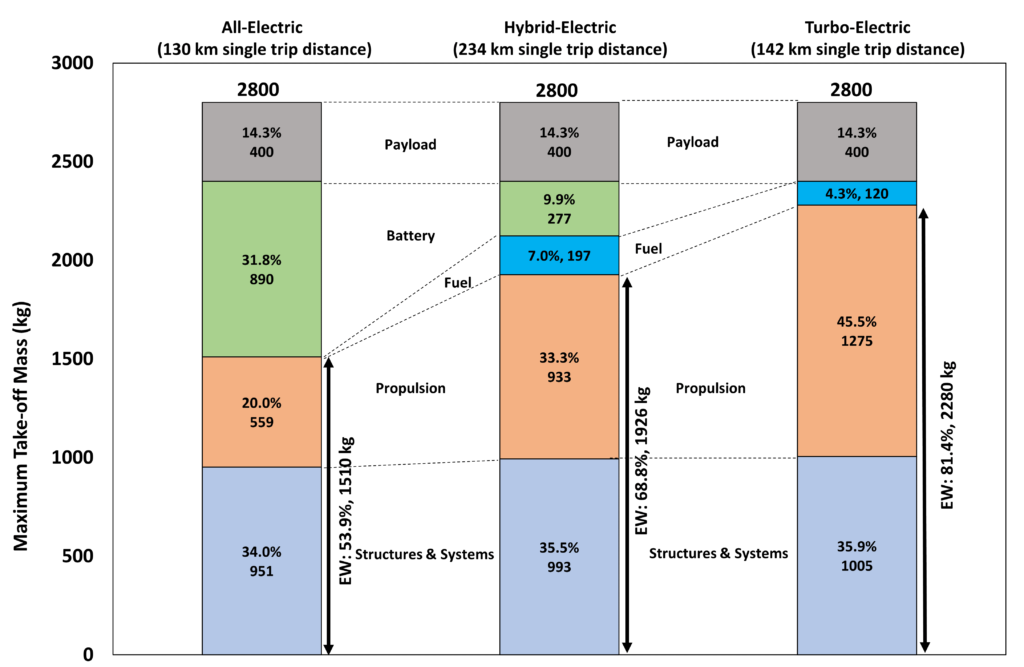
Some general characteristics of the configuration, sized to 2,800 kg (6,173 lb), are provided below.
Wingspan: 11.74 m (38.52 ft)
Wing area: 11.5 sq.m (123.5 sq.ft)
Wing loading: 244 kg/sq.m (50 lb/sq.ft)
Lift propulsors: 2-bladed constant-speed propellers x 8
Diameter: 2.14 m (7.02 ft)
Motors: 8 x 131 kW (8 x 176 hp)
Disc loading: 98 kg/sq.m (20 lb/sq.ft)
Cruise propulsor: 3-bladed constant-speed propeller, driven by a 388 kW (520 hp) electric motor
Batteries (AE and HE): 5 packs, at 400 Wh/kg specific energy and 2 kW/kg specific power technology level
Power: 5 x 252 kW (AE), 5 x 111 kW (HE)
Total Capacity: 356 kWh (AE), 111 kWh (HE)
Turboshaft engines (HE and TE):
HE: 2 x 398 kW (2 x 534 hp)
TE: 3 x 557 kW (3 x 747 hp)
(rated sea-level power)
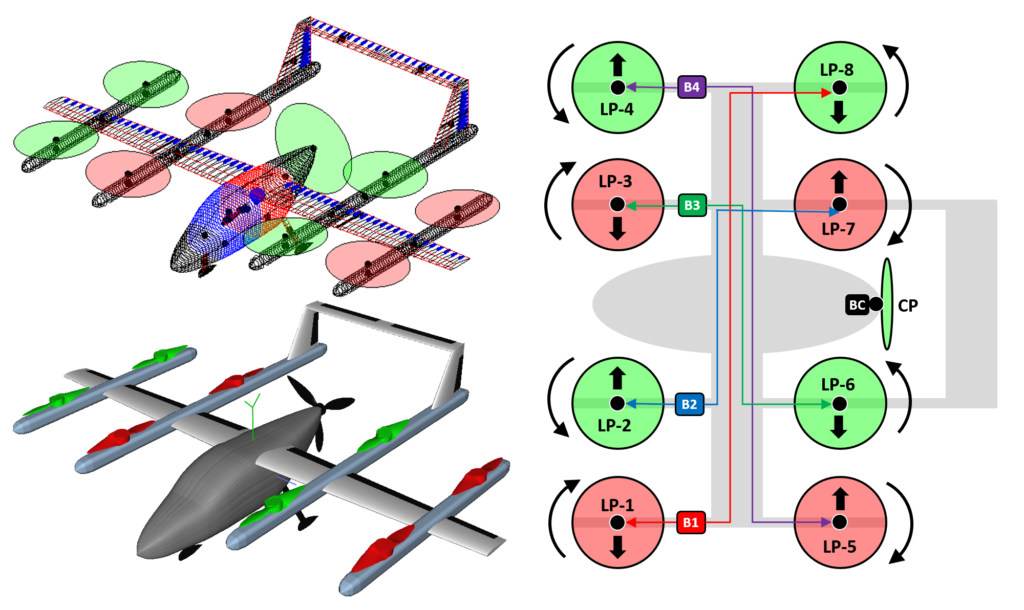
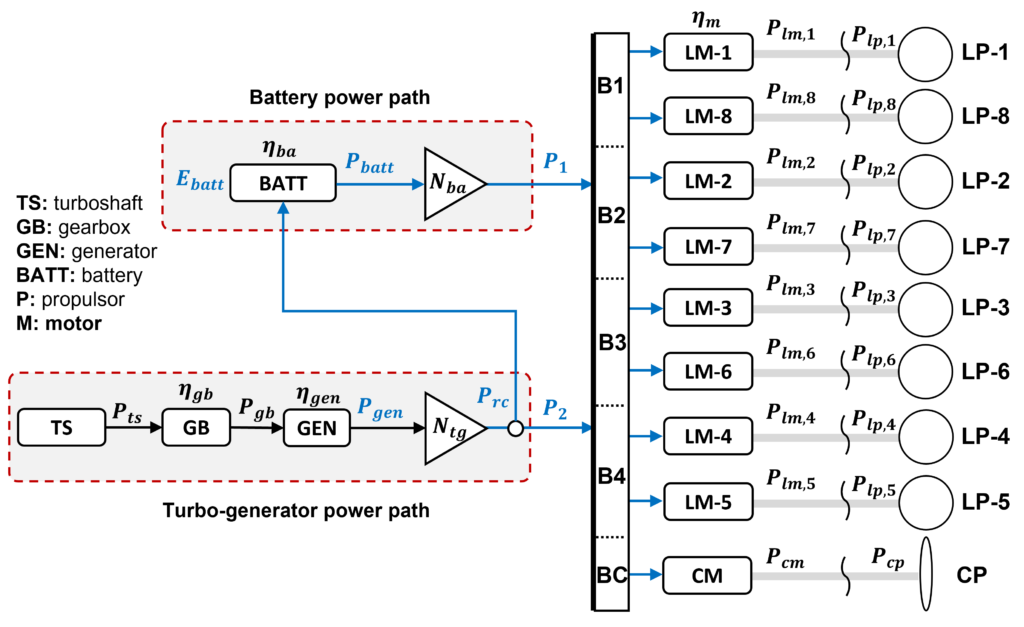
References:
(1) Chakraborty, I. and Mishra, A.A., “Sizing and Analysis of a Lift-Plus-Cruise Aircraft with Electrified Propulsion,” AIAA Journal of Aircraft, Vol. 60, No. 3, pp. 747-765 (Article in Advance, Nov 1, 2022), DOI: 10.2514/1.C037044
(2) Bhandari, R., Mishra, A.A., and Chakraborty, I., “Genetic Algorithm Optimization of Lift-Plus-Cruise VTOL Aircraft with Electrified Propulsion,” AIAA Journal of Aircraft, Article in Advance, Jan 18, 2024, DOI: 10.2514/1.C037343
(3) Comer, A. and Chakraborty, I., “Total Energy-Based Control Architecture Design and Optimization for a Lift-Plus-Cruise Aircraft,” AIAA Journal of Guidance, Control, and Dynamics, Article in Advance, March 31, 2024, DOI: 10.2514/1.G007605
LPC-03-s Phoenix Lite (subscale)

The LPC-03-s Phoenix Lite is the subscale version of the LPC-03 Phoenix lift-plus-cruise design. Its flight control architecture comprises VSDDL’s Trajectory Control System (TCS) with explicit model-following (EMF) inner-loop controllers as part of VSDDL’s Simplified Vehicle Operations (SVO) philosophy. Previous iterations of the vehicle flew with a modified Total Energy Control System (TECS) with linear-quadratic-integral (LQI) inner-loop controllers.
MTOM: 8.30 kg (18.3 lb)
Wingspan: 1.50 m (4.92 ft)
Wing area: 0.42 m2 (4.52 ft2)
Wing loading: 19.8 kg/m2(4.05 lb/ft2)
Lift propulsors: Eight 2-bladed APC 12×4.5E 0.31 m (12 in) fixed-pitch props, driven by 0.375 kW (0.50 hp) Cobra CM-2814/36 motors
Cruise propulsor: One 2-bladed APC 17x12E 0.43 m (17 in) fixed-pitch prop, driven by 2.2 kW (2.95 hp) T-Motor AT4125 Long Shaft motor
Hover disc loading: 13.7 kg/m2 (2.81 lb/ft2)
Batteries: One 6S, 10,000 mAh, 120C LiPo battery
References:
Comer, A., Chakraborty, I., Kovryzhenko, Y., Taheri, E., Putra, S.H., Bhandari, R., and Kunwar, B., “Flight Testing of Explicit Model-Following Trajectory Control System for Lift-Plus-Cruise and Tilt-Wing Configurations,” VFS Forum 80, Montreal, Canada, May 7-9, 2024, F-0080-2024-1306
LPC-02 DUeVTOL All-Electric/Hybrid-Electric UAM
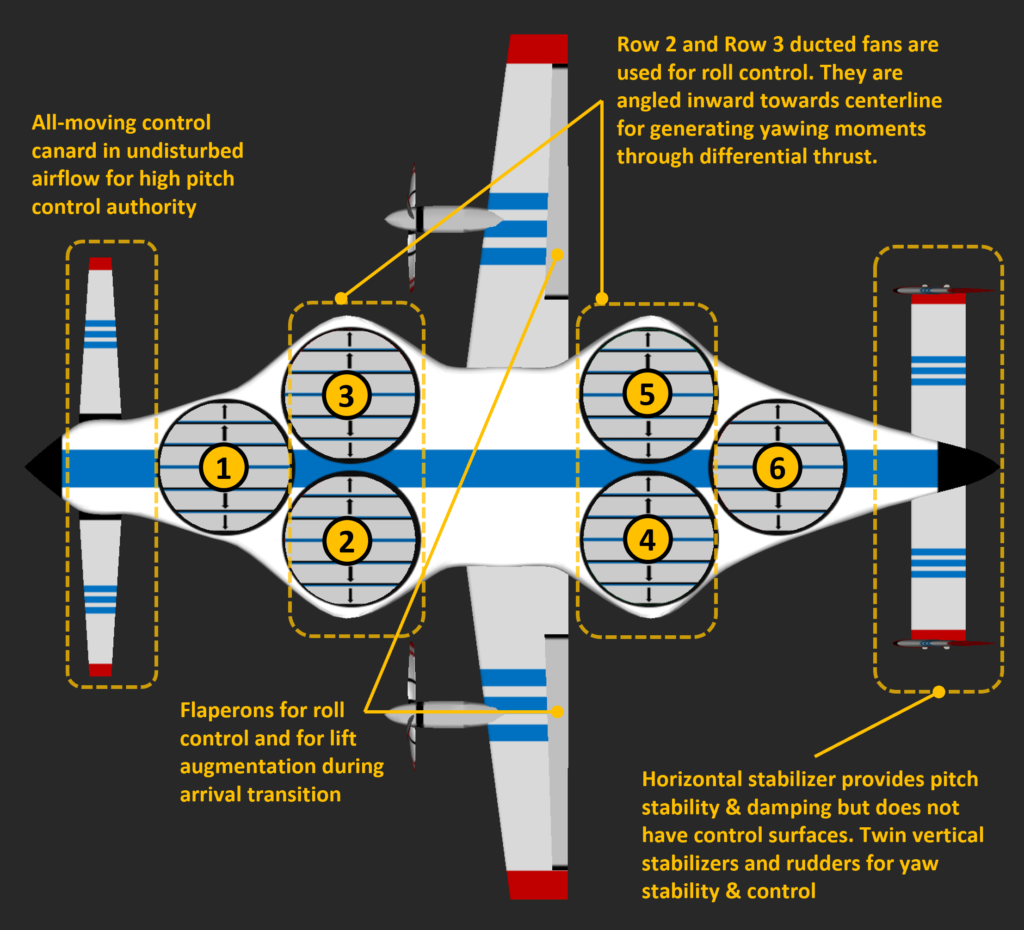
LPC-02 DUeVTOL is a dual-use lift-plus-cruise e-VTOL configuration designed for a 400 kg (882 lb) payload.
In vertical flight mode, six ducted fan lift propulsors housed within a “pancake” provide the necessary thrust. They are shut down and covered by a system of louvers in forward flight mode, where thrust is provided by two wing-mounted cruise propulsors.
Two variants with all-electric and hybrid-electric propulsion systems were sized to the same maximum takeoff mass. The high-level weight breakdown is shown below.
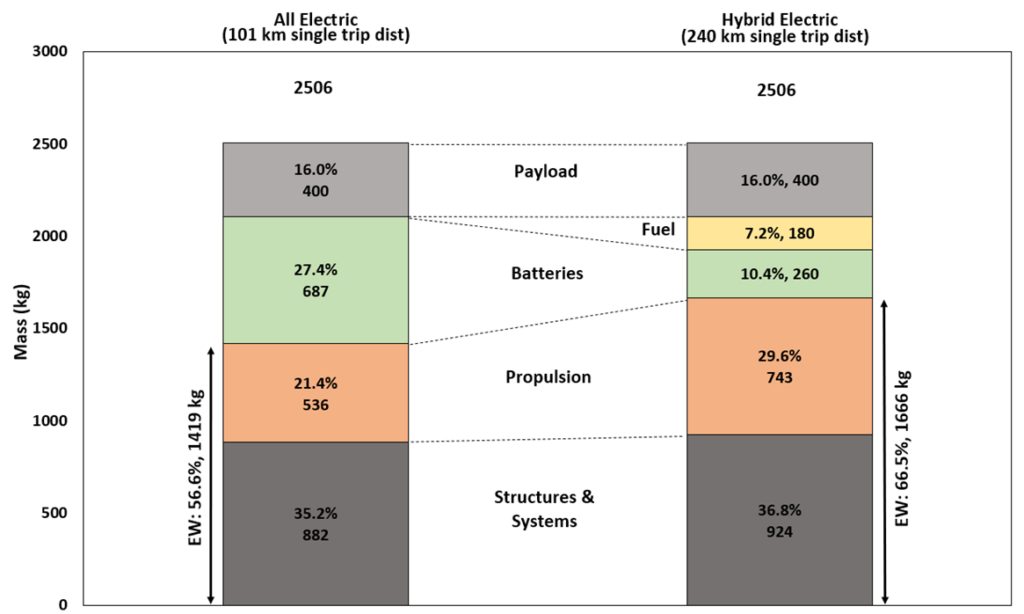
Wingspan: 10.13 m (33.23 ft)
Wing area: 10.3 sq.m (110.9 sq.ft)
Wing loading: 244 kg/sq.m (50 lb/sq.ft)
Lift propulsors: 4-bladed constant-speed ducted rotors x 6
Diameter: 1.59 m (5.22 ft)
Motors: 6 x 158 kW (6 x 212 hp)
Disc loading: 210 kg/sq.m (43 lb/sq.ft)
Cruise propulsors: Two 3-bladed constant-speed propellers, driven by a 271 kW (363 hp) electric motor (all-electric) or a 330 kW (442 hp) turboshaft engine (hybrid-electric)
Battery data:
Packs: 5 (for both all-electric and hybrid-electric variants)
Technology level: 400 Wh/kg, 2 kW/kg
Power: 5 x 196 kW (all-electric), 5 x 104 kW (hybrid-electric)
Capacity: 275 kWh (all-electric), 104 kWh (hybrid-electric)
A flight simulation model of DUeVTOL was developed using MADCASP and deployed to Flight Simulator #3 (Sim 3).
Note: The DUeVTOL configuration was jointly analyzed by VSDDL and DARcorporation as part of a Phase I STTR funded by the USAF Agility Prime Program.
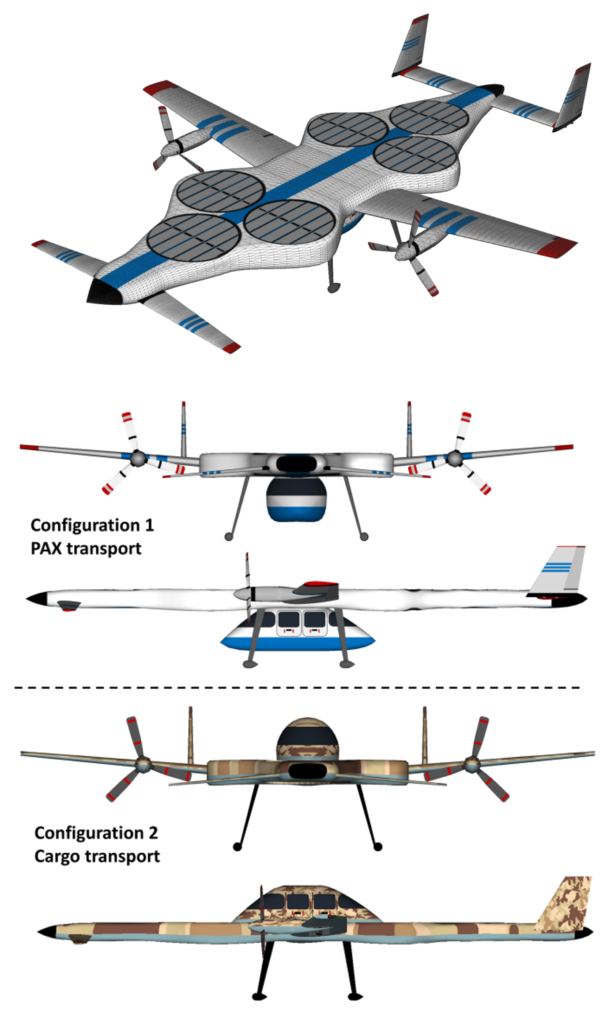
LPC-02 DUeVTOL configurations for dual-use
Sizing mission:
Perform two identical back-to-back trips with maximum payload cruising at 3,000 ft at 200 KTAS with 20% battery state-of-charge at end-of-mission.
Mission profile (repeated twice): Vertical takeoff –> transition to forward flight* –> climb –> cruise –> descent –> transition to vertical flight* –> vertical descent to landing.
(* no distance credit)
References:
(1) Chakraborty, I., Mishra, A.A., Miller, N.S., van Dommelen, D., and Anemaat, W.A., “Design and Sizing of a Dual-Purpose Hybrid-Electric Ducted Fan Lift-Plus-Cruise Aircraft,” AIAA SCITECH 2022 Forum, Jan 3-7, 2022, San Diego CA and virtual, AIAA-2022-1516
LPC-01 Pushpak e-VTOL UAM
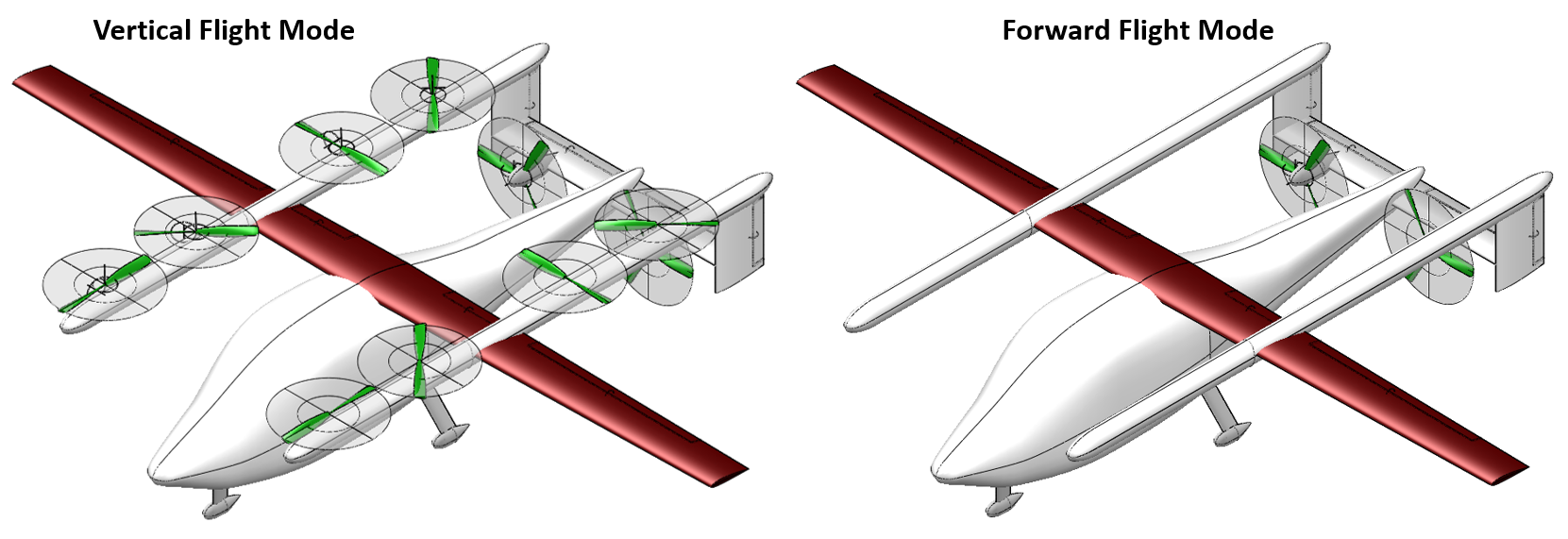
The LPC-01 Pushpak is a lift-plus-cruise all-electric Vertical Takeoff and Landing (e-VTOL) Urban Air Mobility (UAM) vehicle designed to carry up to four occupants.
In vertical flight mode, eight lift rotors mounted on two booms support the weight of the vehicle. In forward flight mode, the lift rotors are stowed and thrust is provided by two empennage-mounted constant-speed cruise propellers.
Empty weight (including batteries): 1,717 kg (3,785 lb)
Maximum takeoff weight: 2,077 kg (4,579 lb)
Payload: 360 kg (794 lb)
Battery weight: 492 kg (1,085 lb)
Battery capacity: 197 kWh (709 MJ)
Wingspan: 11.9 m (39.0 ft)
Wing area: 9.4 sq.m (101.6 sq.ft)
Wing loading: 220 kg/sq.m (45 lb/sq.ft)
Lift rotors: 2-bladed fixed-pitch rotors x 8
Diameter: 1.5 m (4.9 ft)
Motors: 8 x 80 kW (8 x 107 hp)
Disc loading: 147 kg/sq.m (30 lb/sq.ft)
Cruise props: 3-bladed constant-speed propellers x 2
Diameter: 1.5 m (4.9 ft)
Motors: 2 x 144 kW (2 x 193 hp)
Flight control architecture:
Longitudinal: Total Energy Control System (TECS)
Lateral: Total Heading Control System (THCS)
Technology Assumptions:
Batteries: 400 Wh/kg (installed), 96% efficiency
Motors: 5 kW/kg (including inverter), 95% efficiency
Power cabling: 200 kVA.m/kg, 98.5% efficiency
Sizing mission:
Perform two identical back-to-back 80 km/43 NM/50 SM trips with maximum payload cruising at 3,000 ft at 175 KTAS with 20% battery state-of-charge at end-of-mission.
Mission profile (repeated twice): Vertical takeoff –> transition to forward flight* –> climb –> cruise –> descent –> transition to vertical flight* –> vertical descent to landing.
(* no distance credit)
References:
(1) Chakraborty, I., Leonard, C., Comer, A., Mishra, A., and Dewey, J., “A Reconfigurable Flight Simulation Framework Aimed at Novel Flight Vehicle Concepts”, AIAA AVIATION 2020 Forum (virtual event), June 15-19, 2020, AIAA-2020-3190
(2) Chakraborty, I., Mishra, A.A., Comer, A., and Leonard, C., “Total Energy Based Flight Control System Design for a Lift-Plus-Cruise Urban Air Mobility Concept,” AIAA SCITECH 2021 Forum (virtual event), Jan 11-15 and 19-21, 2021, AIAA-2021-1899
TW-03-s TAC/AU Vy7.5.1 RRTV (subscale)
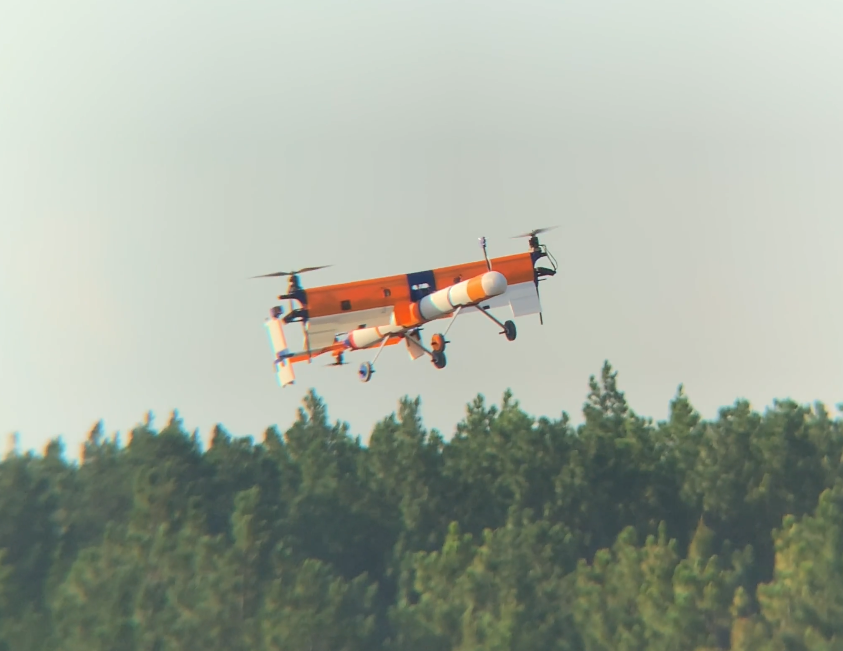
The TW-03-s TAC/AU Vy 7.5.1 Risk Reduction Test Vehicle (RRTV) was developed for a joint project with Transcend Air Corporation, funded by the US Air Force Agility Prime Program. It is a tilt-wing aircraft with wingtip propellers and a tail-fan arrangement for pitch control in hover. Its flight control architecture comprises VSDDL’s Trajectory Control System (TCS) with explicit model-following (EMF) inner-loop controllers as part of VSDDL’s Simplified Vehicle Operations (SVO) philosophy.
MTOM: 8.03 kg (17.7 lb)
Wingspan: 1.36 m (4.46 ft)
Wing area: 0.36 m2 (3.87 ft2)
Wing loading: 22.3 kg/m2(4.56 lb/ft2)
Wing propulsors: Two 2-bladed APC 20x10E 0.51 m (20 in) fixed-pitch props, driven by 2.2 kW (2.95 hp) T-Motor AT4125 Long Shaft motors
Tail fans: Two 2-bladed APC 11×4.5E 0.28 m (11 in) fixed-pitch props, driven by 0.34 kW (0.45 hp) Cobra CM-2814/24 motors
Hover disc loading: 19.6 kg/m2 (4.05 lb/ft2)
Batteries: One 6S, 10,000 mAh, 120C LiPo battery
References:
Comer, A., Chakraborty, I., Kovryzhenko, Y., Taheri, E., Putra, S.H., Bhandari, R., and Kunwar, B., “Flight Testing of Explicit Model-Following Trajectory Control System for Lift-Plus-Cruise and Tilt-Wing Configurations,” VFS Forum 80, Montreal, Canada, May 7-9, 2024, F-0080-2024-1306
TW-02 Pangolin All-Electric/Hybrid-Electric UAM
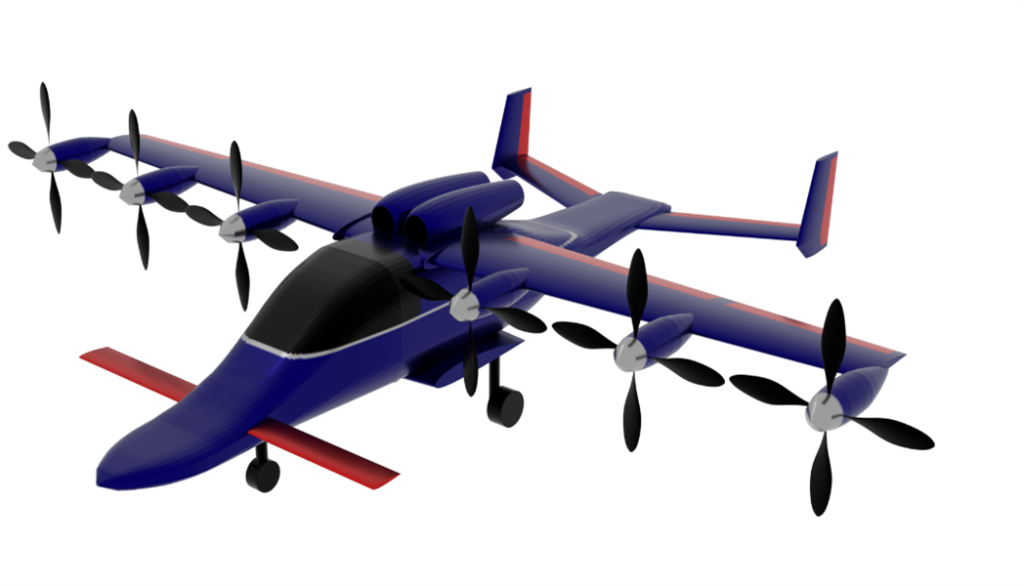
The TW-02 Pangolin is a tilt-wing design with hybrid-electric and turbo-electric propulsion system architectures. It is capable of both vertical takeoff and landing (VTOL) and conventional takeoff and landing (CTOL). The tilting wing has six propulsors (three per side). Each propulsor comprises a variable-pitch propeller driven by an electric motor. Two trim fans (a nose-fan in the nose section and a tail-fan in the tail section) are used to control pitch attitude in vertical flight mode. Control surfaces (all-moving canards in the nose section, inboard and outboard flaperons on the wing, elevators on the horizontal stabilizer, and rudders on each vertical stabilizer) are used for attitude control in forward flight mode.
- MTOM: 4176 kg (9206.5 lb)
- Wingspan: 12.47 m (40.91 ft)
- Wing area: 15.55 m2 (167.37 ft2)
- Canard span: 2.55 m (8.36 ft)
- Canard area: 0.72 m2 (7.75 ft2)
- Wing loading: 269 kg/m2(55 lb/ft2)
- Fans: 4 bladed nosefan x 1, 4 bladed tailfan x 1
- Diameter: 1.17 m (3.83 ft)
- Motors: 2 x 16.4 kW (2 x 22.0 hp)
- Main propulsors: 4-bladed constant-speed propellers x 6
- Diameter: 2.08 m (6.82 ft)
- Motors: 6 x 299 kW (6 x 401.0 hp)
- Disc loading: 204.8 kg/m2 (42.0 lb/ft2)
- Batteries (AE, HE, and TE): 6 packs at 178 Wh/kg specific energy and 0.3 kW/kg specific power technology level
- Power: 6 x 280 kW (AE), 6 x 155 kW (HE), and 1 x 505 kW (TE)
- Turboshaft engines (HE and TE):
- HE: 2 x 420 kW (2 x 563 hp)
- TE: 2 x 1300 kW (2 x 1743 hp)
References
(1) Comer, A. and Chakraborty, I., “Full Envelope Flight Control System Design and Optimization for a Tilt-Wing Aircraft,” Journal of the American Helicopter Society, Fast-track Article, March 13, 2024, DOI: 10.4050/JAHS.69.032003
(2) Comer, A.M., Mishra, A.A., and Chakraborty, I., “Total Energy Flight Control Architecture Optimization for a Tilt-Wing Aircraft,” AIAA AVIATION 2023, San Diego, CA, June 12-16, 2023, AIAA-2023-4510
(3) Mishra, A.A. and Chakraborty, I., “Flight Dynamics and Control Integration in Conceptual Design of an Advanced Air Mobility VTOL Aircraft,” AIAA AVIATION 2024, Las Vegas, NV, Jul 29 – Aug 2, 2024, AIAA-2024-4050
(4) Mishra, A.A. and Chakraborty, I., “Integrating Stability and Control Considerations into the Sizing of an Advanced Air Mobility VTOL Aircraft,” AIAA SCITECH 2024, Orlando, FL, Jan 8-12, 2024, AIAA-2024-2316
TW-01 Minokawa All-Electric/Hybrid-Electric UAM
The TW-01 Minokawa is a tilt-wing UAM aircraft designed for a 400 kg (882 lb) payload. It has three tilting surfaces: the forward canard, the main wing, and the aft horizontal stabilizer (which is mounted atop twin vertical stabilizers).
There are a total of eight identical propulsors, each comprising an electric motor driving a constant-speed propeller. Four of them are mounted on the wing, two on the canard, and the remaining two on the horizontal stabilizer.
The landing gear arrangement comprises three gear struts, each with a single wheel. Two struts are integrated with the canard-mounted propulsor nacelles. The third extends vertically downward from aft of the passenger cabin aft bulkhead.
Using VSDDL’s PEACE sizing framework, two variants with all-electric and hybrid-electric propulsion systems were sized to the same maximum takeoff mass. The high-level weight breakdown is shown below.
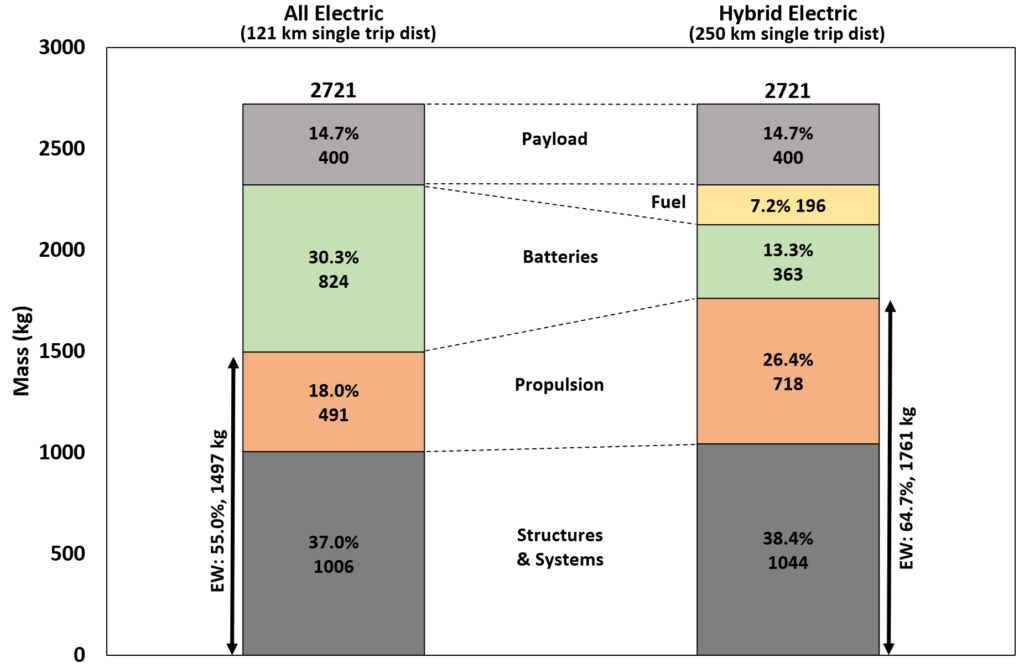
Wingspan: 10.56 m (34.65 ft)
Wing area: 11.14 sq.m (119.91 sq.ft)
Wing loading: 244 kg/sq.m (50 lb/sq.ft)
Disc loading: 122 kg/sq.m (25 lb/sq.ft)
Propulsors: Eight 2-bladed constant-speed propellers, diameter 1.88 m (6.17 ft), each driven by a 158 kW (212 hp) electric motor
Battery data:
Packs: 4 (for both all-electric and hybrid-electric variants)
Technology level: 400 Wh/kg, 2 kW/kg
Power: 4 x 303 kW (all-electric), 4 x 182 kW (hybrid-electric)
Capacity: 330 kWh (all-electric), 145 kWh (hybrid-electric)
Turboshaft engines (for hybrid-electric): 2 x 242 kW (2 x 325 hp)
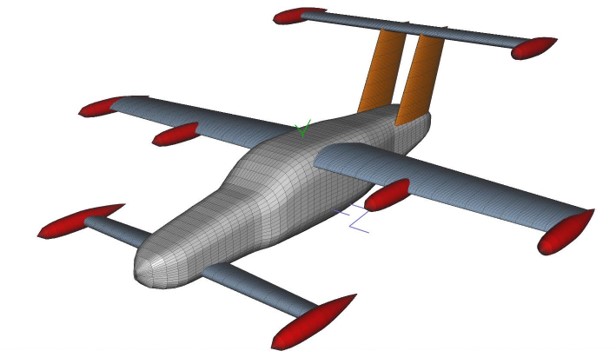
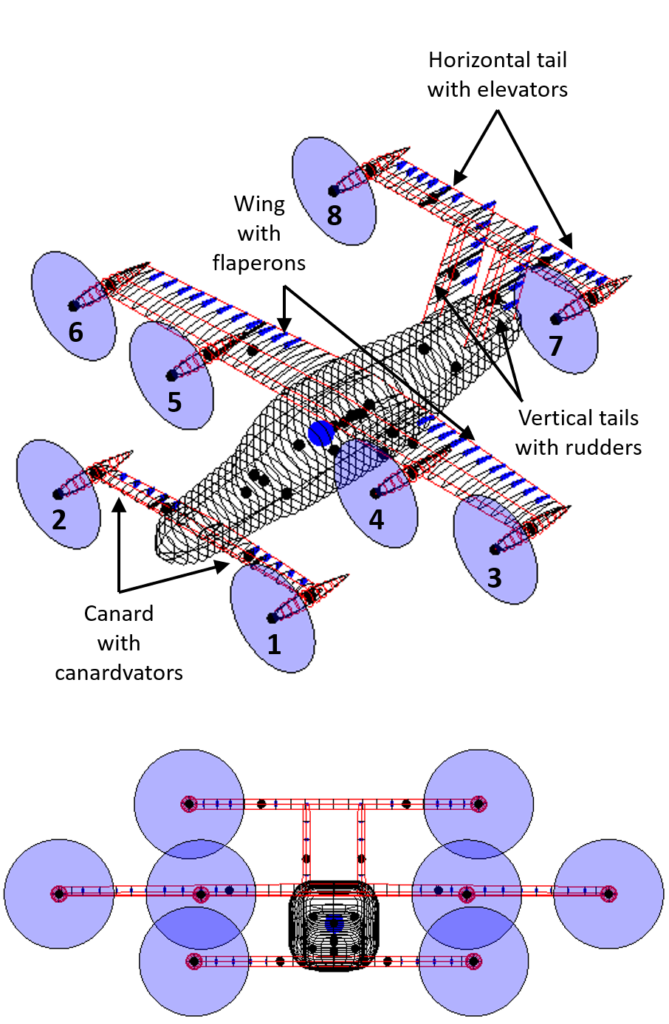
Sizing mission:
Perform two identical back-to-back trips with maximum payload cruising at 3,000 ft at 200 KTAS with 20% battery state-of-charge at end-of-mission.
Mission profile (repeated twice): Vertical takeoff –> transition to forward flight* –> climb –> cruise –> descent –> transition to vertical flight* –> vertical descent to landing.
(* no distance credit)
References:
(1) Chakraborty, I., Miller, N.S., and Mishra, A.A., “Sizing and Analysis of a Tilt-Wing Aircraft with All-Electric and Hybrid-Electric Propulsion Systems,” AIAA SCITECH 2022 Forum, Jan 3-7, 2022, San Diego CA and virtual, AIAA-2022-1515
(2) Chakraborty, I. and Mishra, A.A., “Sizing of Tilt-Wing Aircraft with All-Electric and Hybrid-Electric Propulsion,” AIAA Journal of Aircraft, Article in Advance, August 15, 2022, DOI: 10.2514/1.C036101
VT-03-s Shadow (subscale)

The VT-03-s Shadow was developed based on the NASA RAVEN-SWFT configuration, except with fixed-pitch propellers. It is a vectored thrust multi-tilt-rotor concept with four tilting propellers and two lift propellers. Two tilting propellers are located at the wingtips and the other two are located at the forward ends of the two wing-mounted booms. The lift propellers are located at the aft ends of the booms. Its flight control architecture comprises VSDDL’s Trajectory Control System (TCS) with explicit model-following (EMF) inner-loop controllers as part of VSDDL’s Simplified Vehicle Operations (SVO) philosophy.
MTOM: 7.40 kg (16.3 lb)
Wingspan: 1.51 m (4.95 ft)
Wing area: 0.30 m2 (3.23 ft2)
Wing loading: 24.7 kg/m2 (5.06 lb/ft2)
Lift propulsors: Two 2-bladed APC 15x4E 0.38 m (15 in) fixed-pitch props, driven by 1.15 kW (1.54 hp) T-Motor AM480 motors
Main propulsors: Four 2-bladed APC 15x10E 0.38 m (15 in) fixed-pitch props, driven by 1.15 kW (1.54 hp) T-Motor AM480 motors
Hover disc loading: 10.8 kg/m2 (2.21 lb/ft2)
Batteries: One 6S, 10,000 mAh, 120C LiPo battery
VT-02 Sevak

The VT-02 Sevak was developed in response to the Vertical Flight Society (VFS) Design Competition 2024 Request for Proposal titled “Multi-Mission Modular UAV for Disaster Relief”. It is a vectored thrust design with six tilting propulsors mounted on a single carry-through spar, two buried nose-fans in the nose section, and two buried tail-fans in the tail section. It is a canard-wing design with a lifting canard. Its flight control architecture comprises VSDDL’s Trajectory Control System (TCS) with explicit model-following (EMF) inner-loop controllers as part of VSDDL’s Simplified Vehicle Operations (SVO) philosophy.
MTOM: 160 kg (353 lb)
Wingspan: 5.66 m (18.57 ft)
Wing area: 1.74 m2 (18.73 ft2)
Canard span: 3.62 m (11.87 ft)
Canard area: 0.68 m2 (7.32 ft2)
Canard area ratio: 0.28 (canard area / (canard area + wing area))
Wing loading: 66.1 kg/m2 (13.5 lb/ft2)
Main propulsors: Six 2-bladed fixed-pitch propellers, 0.59 m (1.93 ft) diameter, driven by six 3.94 kW (5.28 hp) motors
Ducted fans: Four 9-bladed ducted fans, 0.24 m (0.79 ft) diameter, driven by four 8.7 kW (11.6 hp) motors
Hover disc loading: 58.5 kg/m2 (12.0 lb/ft2) for main propellers, 353.7 kg/m2 (72.0 lb/ft2)
Hover thrust share: main propulsors 60%, ducted fans 40%
Propulsion system: Hybrid-electric, 9.2 kW turboshaft engine, battery weight 22.1 kg (49.2 lb), Jet-A fuel weight 43.6 kg (91.4 lb).
References:
Vertical Flight Society Design Competition 2024 Request for Proposal:
“Multi-Mission Modular UAV for Disaster Relief” (Link to RFP)
Hexa-Chakra Personal Air Vehicle (HCPAV)
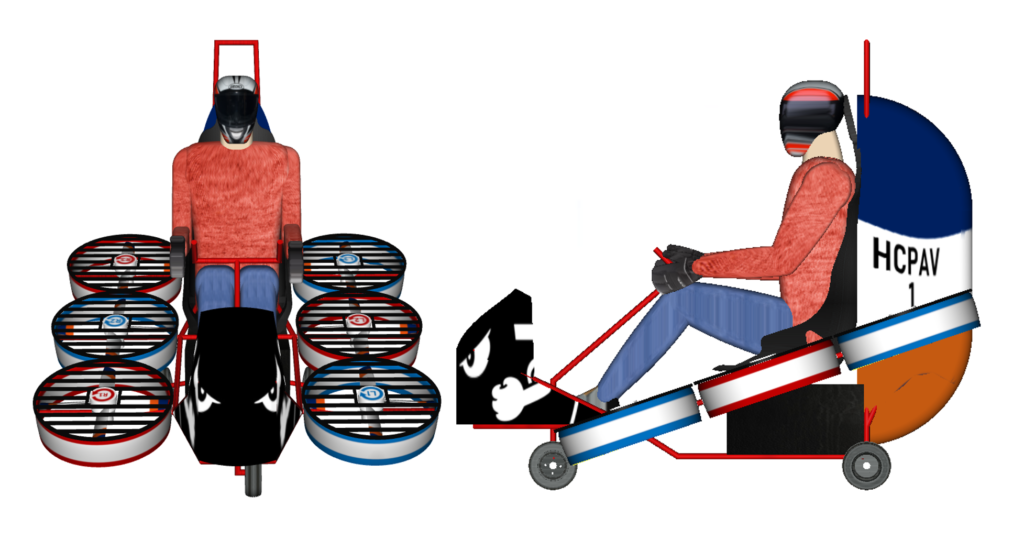
The Hexa-Chakra Personal Air Vehicle (HCPAV) was designed for Phase I of the HeroX GoFly competition. It is a single-occupant fly-by-wire electric Vertical Takeoff and Landing (e-VTOL) personal air vehicle (PAV).
The occupant sits in a Tillett B7 racing seat with safety harnesses and an interface for a Head and Neck Safety (HANS) device. A soft-pack type Ballistic Recovery System (BRS) canister is mounted onto the roll hoop. The propulsion system is composed of six 4-bladed fixed-pitch ducted rotors arranged in a Hexa-H configuration.
Length: 1.69 m (5.54 ft)
Width: 1.41 m (4.64 ft)
Height: 1.48 m (4.87 ft)
Gross weight: 249 kg (547 lb)
Empty weight: 158 kg (347 lb)
Max occupant weight: 91 kg (200 lb)
Battery weight: 97 kg (213 lb)
Battery capacity: 27.15 kWh (97.74 MJ)
Propulsors: 4-bladed ducted rotors x 6
Diameter: 0.47 m (18.5 in)
Drive motors: 6 x 12 kW BLDC
Flight control architecture:
Longitudinal: Total Energy Control System (TECS)
Lateral: Total Heading Control System (THCS)
Technology Assumptions:
Batteries: 280 Wh/kg (installed), 460 Wh/L
Motors: 3.5 kW/kg (including inverter)
Best endurance speed (VBE): 52 KTAS
Endurance @ VBE: 24 min + 10 min reserve
Sizing mission: GoFly competition mission profile, involving vertical takeoff followed by climb to a safe altitude, speed run of six laps around a 1 NM course, demonstration of a touch-and-go landing, loitering to demonstrate at least 20 minutes endurance, followed by descent and vertical landing.
References:
(1) Chakraborty, I., “Design Overview of the Hexa-Chakra Electric Vertical Takeoff and Landing Personal Air Vehicle”, AIAA SCITECH Forum 2019, San Diego, CA, Jan 7-11, 2019, AIAA-2019-0554
(2) Chakraborty, I., Ahuja, V., Comer, A., and Mulekar, O., “Development of a Modeling, Flight Simulation, and Control Analysis Capability for Novel Vehicle Configurations”, AIAA AVIATION Forum 2019, Dallas, TX, Jun 17-21, 2019,
AIAA-2019-3112
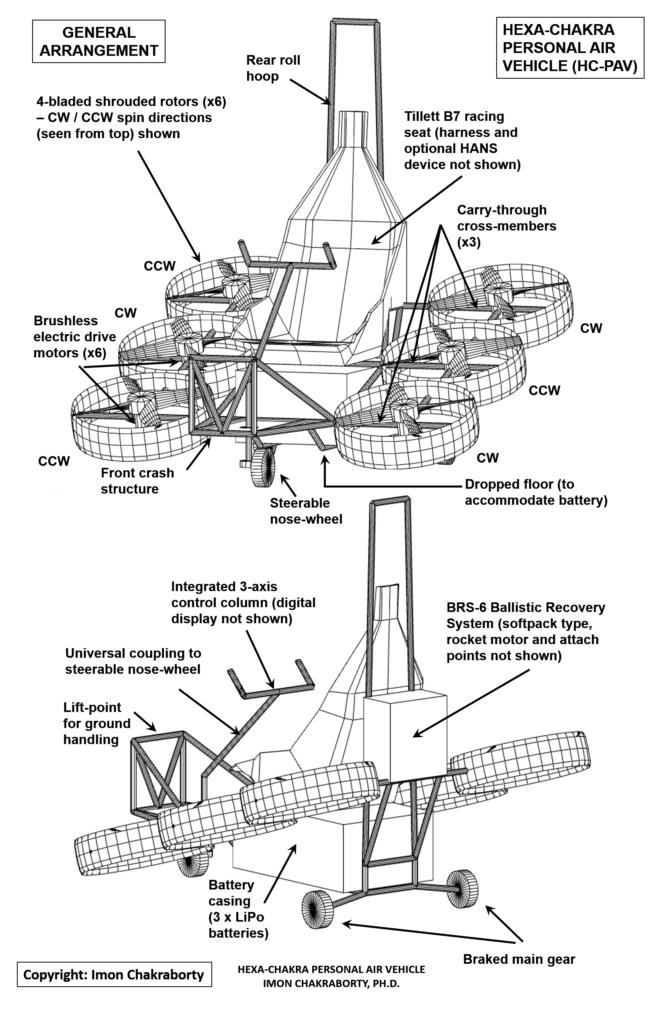
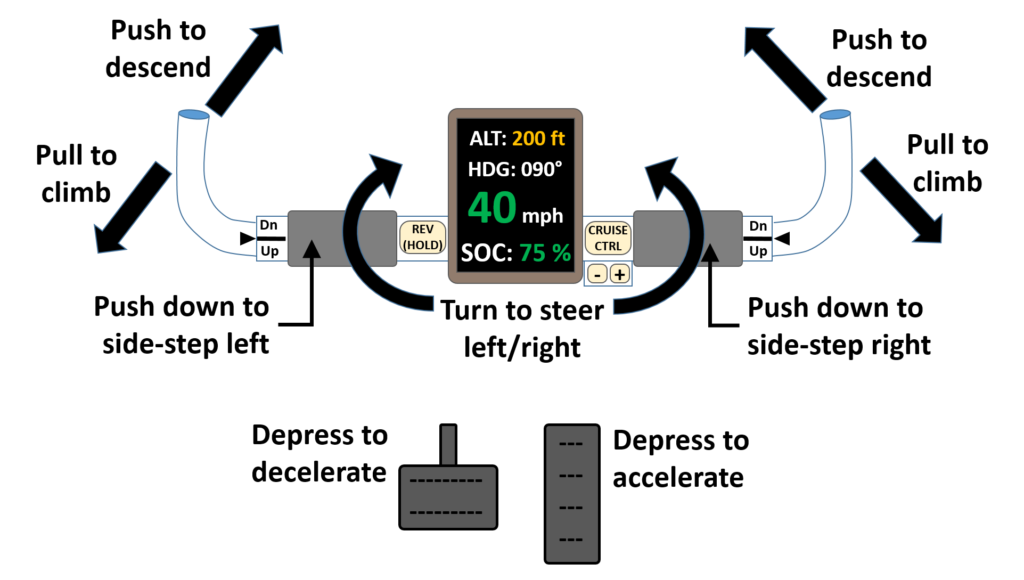
HCPAV inceptor design
Inceptor design: The HCPAV inceptors were designed with Simplified Vehicle Operations (SVO) and similarity to common ground vehicles in mind. Automobile-style “accelerator” and “brake” pedals control forward velocity. The motorcycle/bicycle-style handlebars have three degrees of motion. Pushing down on the left and right sides controls side-stepping motion to the left and right respectively. Twisting to the left and right controls turning motion. Pulling or pushing on either of the horns (which are torque-tubed together) controls vertical velocity.

